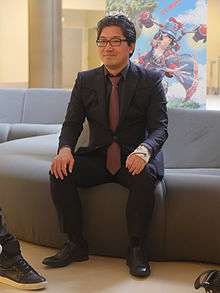Yuji Naka
| Yuji Naka | |
|---|---|
 | |
| Born |
September 17, 1965 Osaka, Osaka Prefecture, Japan |
| Occupation | Game designer, producer, programmer |
| Years active | 1983-present |
| Known for | Sonic the Hedgehog series |
Yuji Naka (中 裕司 Naka Yūji, born September 17, 1965) is a Japanese video game programmer, designer, and producer best known as the former head of Sonic Team, where he was the lead programmer of the original Sonic the Hedgehog series of games on the Sega Genesis. Since 2006, he has been the head of Prope, a game company he founded after leaving Sonic Team that same year.
Career
Naka learned how to program by replicating and debugging video game code printed in magazines. The experience prompted him to study assemblers and practice writing code during his school classes.[1] After graduating high school, Naka decided to skip university and stay in his home town.[2]
Around 1983, Naka saw that Sega was looking for programming assistants and decided to apply. After a brief interview, he was hired and his first project was a game called Girl's Garden, which he and Hiroshi Kawaguchi created together as part of their training process.[3] Their boss was impressed and decided to publish the game, and it earned them notice among their peers and Japanese gamers.[1] Naka's abilities as a programmer were further demonstrated in 1987 for his work on Phantasy Star for the Master System, where he was responsible for the impressive pseudo-3D animation effects present in the game's first-person dungeons.
His true breakthrough, however, came in 1991 when he programmed the original Sonic the Hedgehog game for the Genesis, with Naoto Ohshima designing the characters and Hirokazu Yasuhara creating the stages. The origins of Sonic can be traced farther back to a tech demo created by Naka, who had developed an algorithm that allowed a sprite to move smoothly on a curve by determining its position with a dot matrix. Naka's original prototype was a platform game that involved a fast-moving character rolling in a ball through a long winding tube, and this concept was subsequently fleshed out with Oshima's character design and levels conceived by Yasuhara.[4] Following Sonic The Hedgehog's release, Naka moved to Sega's U.S. branch, Sega Technical Institute, where he worked with famed American designer Mark Cerny on the follow-up in conjunction with the original team back in Japan, now known as "Sonic Team". This partnership between the Eastern and Western teams continued through the development of Sonic the Hedgehog 3 and Sonic & Knuckles, though the bulk of the development duties shifted back to Sonic Team in Japan for those titles, which Naka had also returned to by that time.
After the release of Sonic & Knuckles, Naka was moved up to the role of producer at Sega Enterprises in Japan. During his tenure in that position, he oversaw titles including Nights into Dreams... and Burning Rangers for Sega Saturn; Sonic Adventure and Phantasy Star Online for Dreamcast; Billy Hatcher and the Giant Egg for Nintendo GameCube; and the "EyeToy" game Sega Superstars for PlayStation 2.
On March 16, 2006, Naka announced that he intended to create his own game studio, Prope, and that he would be leaving Sega to do so.[5] Naka stated that he considered it a benefit to be able to create games other than Sonic the Hedgehog titles.[6] Following Naoto Ohshima's and Hirokazu Yasuhara's departure by 2002, Naka was the final member of the original creative core that created Sonic the Hedgehog to leave Sega.
Works
- Girl's Garden (1984) — Game Designer, Programmer
- Spy vs. Spy (Sega Master System) (1986) — Lead Programmer
- Phantasy Star (1987) — Programmer
- Phantasy Star II (1989) — Producer, Programmer
- Ghouls 'n Ghosts (Genesis) (1989) — Programmer
- Sonic the Hedgehog (1991) — Lead Programmer
- Sonic the Hedgehog 2 (1992) — Lead Programmer
- Sonic the Hedgehog 3 & Knuckles (1994) — Producer, Lead Programmer
- Nights into Dreams (1996) — Producer, Lead Programmer
- Burning Rangers (1998) — Producer
- Sonic Adventure (1998) — Producer
- ChuChu Rocket! (1999) — Director, Producer
- Samba de Amigo (2000) — Producer
- Phantasy Star Online (2000) — Producer
- Sonic Adventure 2 (2001) — Producer
- Sonic Advance (2001) — Producer
- Sonic Advance 2 (2002) — Producer
- Sonic Pinball Party (2003) — Producer
- Billy Hatcher and the Giant Egg (2003) — Producer
- Sonic Battle (2003) — Producer
- Sonic Heroes (2003) — Producer
- Sonic Advance 3 (2004) — Producer
- Puyo Pop Fever (2004) — Producer
- Sakura Wars: So Long, My Love (2005) — Producer
- Shadow the Hedgehog (2005) — Producer
- Sonic Rush (2005) — Producer
- Puyo Puyo Fever 2 (2005) — General Producer
- Sonic Riders (2006) — Executive Producer
- Phantasy Star Universe (2006) — Executive Producer
- Let's Tap (2008) — Producer
- Ivy the Kiwi? (2009) — Designer
- Fishing Resort (2011) — Creator
- StreetPass Mansion/Monster Manor (2013) — Producer
- Hi-sCoool! SeHa Girls (2014) — Voice actor ("Center-sensei")
- Rodea the Sky Soldier (2015) — Producer (original Wii version)
References
- 1 2 Szczepaniak, John. "Before They Were Famouos". Retro Gamer. Imagine Publishing (35): 74.
- ↑ Horowitz, Ken (22 June 2005). "Sega Stars: Yuji Naka". Sega-16. Retrieved 5 July 2016.
- ↑ "The Making of OutRun". NowGamer. 29 April 2016. Retrieved 8 April 2016.
- ↑ GI Staff (August 2003). "Sonic's Architect: GI Interviews Hirokazu Yasuhara". Game Informer. 13 (124): 114–116.
- ↑ Edge Staff (2006-05-08). "Confirmed: Yuji Naka Leaves Sega". Edge. Retrieved 2010-02-18.
- ↑ http://www.escapistmagazine.com/news/view/119722-Sonic-Creator-Left-Sega-to-Avoid-Making-More-Sonic-Games
External links
- Official Prope website (Japanese)
- Sonic Team Speaks (archived by the WaybackMachine)
- Sega's Yuji Naka Talks!
- Yuji Naka On New Beginnings At His Studio, Prope
- Life after Sega: The Sonic creator talks about being free of the hedgehog